The Plight of the Small Farmer in Farmville
Starting Tips, Tricks, Strategies, and Good Game Play HabitsPrevious Page
New Version Changes
Before we begin the proper walkthrough and guide, and before we start to reveal the Tips and Tricks, the different methods to maximize the return on your investments of time and resources, and find ourselves deep in the details of crops, animals, buildings and the like, we need to address the foundation of game play, and a very essential underpinning to playing Farmville 2, and that is the plight of the Small Farmer.
It may interest you to know that the situation in Farmville 2 mirrors the situation in reality in a number of ways, though that was clearly not the intention of the developers at Zynga when they created the sequel to the original game. The small farmer today – and we are talking about the real-world small farmer, not the one in the game – faces serious competition from the huge corporate mega-farming operations who gobble up entire farming areas and turn what was previously a collection of family farms into a single massive operation that leverages the interlocking supply systems that the mega-corp uses to control costs to the point that they can do business and sell their production at rates far below what the small farm and farmer must charge in order to remain profitable.
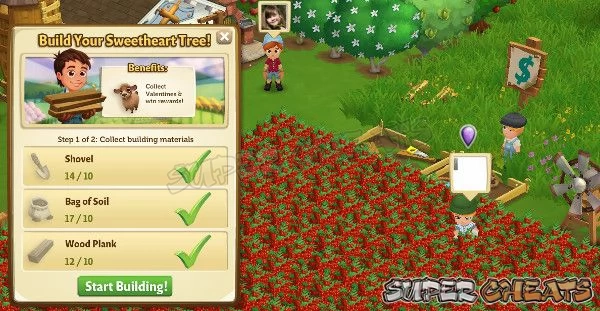
The mega-corps interest is in turning out a single specific agricultural product, which it sells for a set price, mostly to other large corporation in the food-industry who use the agriculture product as part of their products. A good example of this is the humble potato, which is grown in vast quantities in Idaho, Washington, Wisconsin, Colorado, and Oregon. While other states produce the potato in significant quantities, it is those five states that lead the nation in production, and it is also those five states that have the smallest number of farming operations, due largely to the fact that they are a base of operations for mega-corps in the farming industry.
The model that is used is to build large production capabilities in a region, and then build large processing facilities that can be shared in the region – for example Idaho and Washington state share processing facilities for several well-known agricorp operations, with the potato crops being trucked directly to the processing facilities by trucks that are owned by the agricorp, where they are processed into potato products and flash-frozen, packaged under a variety of brand names, and trucked to distribution centers again owned by the agricorp, to be sold into the food supply chain to large grocery store and food service industry companies, as well as institutional customers and restaurant chains, the vast majority of which then move the products into their own distribution systems.
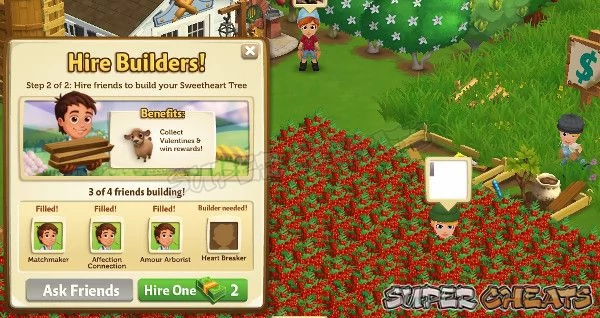
In the case of very large food-industry companies – McDonalds Corporation is a good example of this – while their primary function is a different stage of the food-industry, the operation of agribusiness is of critical strategic value to them because it cuts out a large portion of the expenses that are incurred due to the supply chain and middle-man elements. McDonalds owns its own potato farms, grows the specific type of potato that it needs for its business to create the hash brown and french fried potatoes it sells in is restaurants, and handles every single aspect of that production from planting the seeds to processing and packaging the finished food product. It does the same for its beef and pork Supplies, and though it is not universal throughout the world, where it is economically practical the company also grows and packages its own salad ingredients.
You now understand the basic elements of big agribusiness, so you are probably wondering how that could possibly relate to the small farm and farmer that we are simulating in the Farmville series, right? Well, it has more impact than you might have suspected, and what is more, understanding that mindset will help you to maximize the profits you make in the game because it clarifies your motivation!

Small Farm Economics in Farmville
The first element of significance is understanding that the crops you are growing on your farm are not the principal source of income for your farm. Sure, you can grow those crops and then sell them via the Farm Market Stall in front of your farm, and you can even make a small profit in the process, but that is not the revenue stream that you are meant to be pursuing, and save for the rare emergency when you need to convert some of your stored goods into cash in order to address some other interest, such as acquiring sufficient coins to expand the size of your farm, it should be the last thing you think of when it comes to making money!
The crops that you grow should be a strategic element in producing finished goods that have a far greater value than the value of their sum components. To provide you with the most basic of examples of this so that it makes sense to you and puts you on the optimal mental path, take the lowly Lemon Tree as an example. As part of the diversification for crop resources, the game will introduce tree planting and production as part of the tutorial phase for play, and you will find yourself planting a tree or two, and so routinely harvesting tree-based crops as a result. One of those trees – and crops – will be Lemon Trees and Lemons.
Due to the rapidity of growth and the convenience you may very well find yourself using the Lemons as a core ingredient in creating Animal Feed – there is nothing wrong with that really, and you do have to feed the animals on your farm, but consider an alternative to using your Lemons in that fashion for a moment...

The Basic Economics of the Lemon Tree
When you open the farm store interface and select the tree section, the first page of the catalog tends to feature the various time-limited special purchases that are part of the catalog, such as the Paw Paw Tree, or specialist trees like the Mandarin Orange tree. After you go through the specialist trees (often starting on page two of the tree portion of the catalog) you will find the basic trees, among which is the Lemon Tree!
The Lemon Tree Vital Statistics:
- Lemon Tree Base Cost: 260c
- Lemon Tree Growth Timer: 12 Hours
- Lemon Tree Resource - Profit: Varies
- Lemon Tree Resource - Resource 1: Lemons
- Lemon Tree Resource - Resource 2: Valentines
A single Lemon can produce three (3) units of Animal Feed, and has a sale value of 17c. A typical harvest will produce anywhere from three to fourteen Lemons, and those Lemons can be used to create a number of finished goods, including Lemon Meringue Pie, Lemon Water, Lemonade, Strawberry Lemonade, Blood Orange Lemonade, Peach Lemonade, Goji Berry Lemonade, Skeleton Cookies, and Lemon Curd.
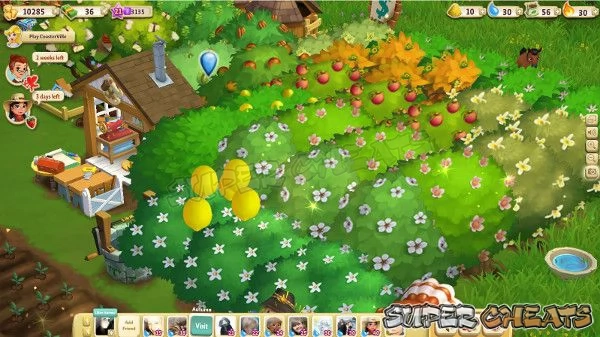
The potential profit from Lemons breaks down by the following:
- Lemon: 17c
- Lemon Water: 150c
- Lemonade: 350c
- Strawberry Lemonade: 630c
- Blood Orange Lemonade: 1720c
- Peach Lemonade: 1030c
- Goji Berry Lemonade: 2510c
- Lemon Meringue: 1200c
- Lemon Meringue Pie: 2400c
- Skeleton Cookies: 950c
- Lemon Curd: 2260c
- Lemon Lavender Scones: 7030c
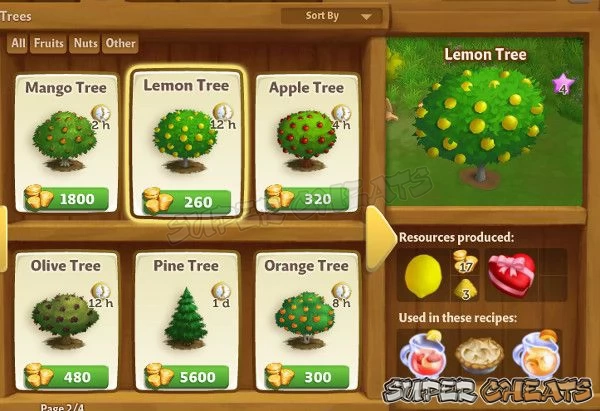
Take the most basic Lemon-based recipe and work out the actual costs and thus the profit and you get:
- Lemon Water Costs
- x2 Lemon = 34c
- x1 Water = 0c
- x1 Fuel = 0c
- Sale Value = 150c (Ingredient Costs 34c) = 116c Total Profit
Now take a more desirable mid-range and complexity Lemon-based recipe that will yield a larger reward:
- Peach Lemonade Costs
- x6 Lemon = 102c (17c per)
- x6 Peaches = 198c (33c per)
- x1 Water = 0c
- x3 Fuel = 0c
- Sale Value = 1030c (Ingredient Costs 300c) = 730c Total Profit
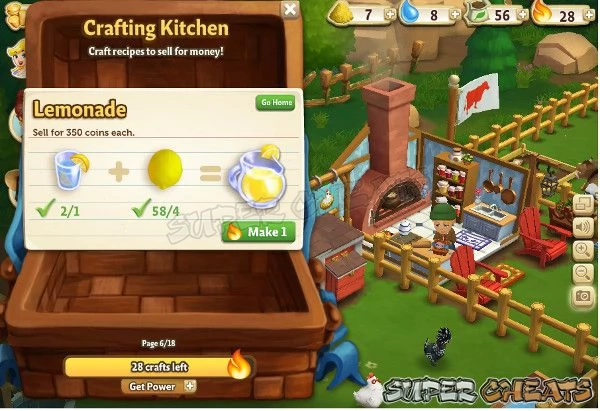
As you advance in your character's level better recipes become available to you, the best of which will yield a very nice reward:
- Lemon Lavender Scones Costs
- x25 Lemons = 425c (17c per)
- x29 White Eggs = 1740c (60c per)
- x4 Rye = 440c (110c per)
- x6 Lavender = 1068c (267c per)
- x3 Fuel = 0c
- Sale Value = 7030c (Ingredient Costs 3673c) = 3357c Total Profit
The Final Analysis
While the recipe for Lemon Lavender Scones results in a profit of 3357c the process that the farmer has to go through in order to create that profit is considerably more complicated than, for instance, the process of making Peach Lemonade, which has a profit of just 730c per unit.
The reason it is more complicated has to do with the number of steps that are required for making the Lavender Scones, which starts with growing the Rye Crop, then turning it into Rye Flour, which is mixed with Eggs to make Rye Batter. Lemons are mixed with Eggs to make Lemon Curd next, and then Lavender Batter is created using Rye Batter and Lavender. Finally the Lavender Batter is combined with Lemon Curd and cooked to make Lemon Lavender Scones.
The recipe for Peach Lemonade is much simpler and can be staged in advance by re-mixing the Lemonade and storing it. That allows the player to create that resource as part of the daily conversion process of taking Fuel and turning it into XP, a stage that works very well since Lemons are harvested daily as well. When the player is ready to profit it is simply a matter of using stockpiled resources as opposed to having to deal with time-dependent crops, and another factor in the favor of the Lemonade approach is that there is zero chance for a lost crop, whereas with the more advanced recipe there are two crops – Lavender and Rye – that present potential for loss.
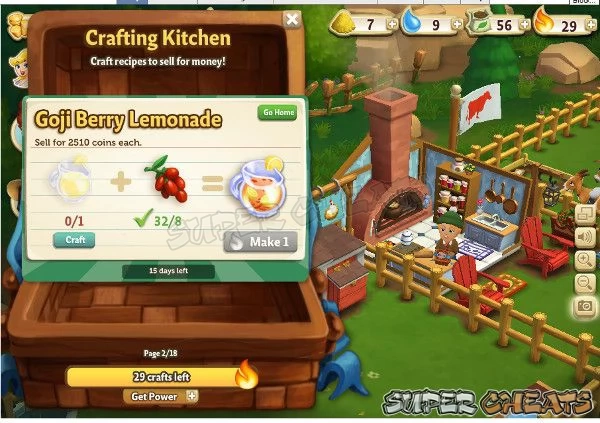
You Get the Idea
The examples above are intended to illustrate several basic points and deliver a secret that is used by the most successful players in the game, which is KISS: Keep It Seriously Simple.
The basic points that are illustrated above are (A) the real money is made by turning the crops you grow into other finished goods, and (B) Volume is always preferable to complexity. Rather than plant loads of different crops and have to worry about having enough of any one harvest, utilizing recipes that are based upon basic production Items like Tree Crops is almost always preferable, since there is less risk, and they tend to stockpile on their own.
If you examine the recipes that are available for your level you will find that there are other examples that you can leverage as you level up.
Starting Tips, Tricks, Strategies, and Good Game Play HabitsPrevious Page
New Version Changes
Anything missing from this guide?
ASK A QUESTION for FarmVille 2
Comments for The Plight of the Small Farmer in Farmville
Add a comment
Please log in above or sign up for free to post comments- Introduction
- New Version Changes
- The Plight of the Small Farmer in Farmville
- Starting Tips, Tricks, Strategies, and Good Game Play Habits
- The Farmville 2 Economics Overview
- Establishing Good Play Habits
- The Missions and Quests Primer
- Known Bugs and Server Issues
- Current and Recent News
- Walkthrough / Guide
- Reference Sections
- Structures
- Special Events
- Addendum
 Join us on Discord
Join us on Discord

So, how do you feed your animals rare treats?